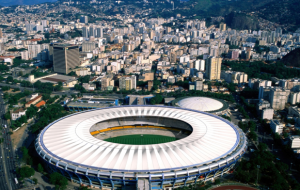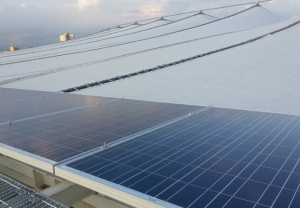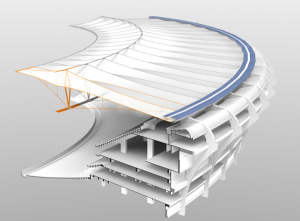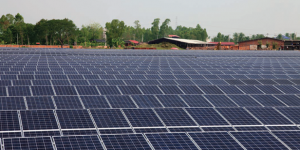Most solar PV systems are installed on buildings or mounted on the ground, if land is not a constraint. In the following case studies, we look at different types of application – roof-mounted, building integrated as well as ground-mounted PV systems.
Case Study 1: MARACANÃ STADIUM, RIO DE JANERIO, BRAZIL
Since the FIFA World Cup™ in 1950, Maracanã Stadium has been renowned as one of football’s most iconic venues. Thanks to recent renovations, the stadium may now become as famous for its sustainability as for its rich football history. As part of FIFA and Yingli Green Energy’s mission to produce the greenest FIFA Confederations Cup and FIFA World Cup™ tournaments in history, Yingli partnered with Light ESCO, EDF Consultoria, Schlaich Bergermann und Partner, and the State of Rio de Janeiro to install more than 1,500 Yingli Solar panels on the roof of the stadium.
The solar project will produce enough electricity to power 240 homes annually, preventing the release of more than 2,560 tons of carbon dioxide into the atmosphere each year. Yingli’s partners overcame the architectural challenges posed by the stadium’s canvas roof by mounting the solar panels on a metal ring encircling the top of the stadium. The prominent placement of the panels will bring green energy to the global stage during the football competitions, helping to raise environmental awareness among football fans worldwide.
Quick Facts
Location: Rio de Janeiro, Brazil
PV Installers: Light ESCO, EDF Consultoria
Connected: June 2013
Mounting Area: 2,380 m2
Rated System Power: 390 kWp
No. / Type of Modules: YGE 60 Cell Series (1,556 units)
Number of Average Homes Powered: 240
Avoided CO2 (per annum): approx. 2,560 metric tons
The panels are mounted on a metal ring that encircles Maracanã Stadium’s canvas roof. Photo Courtesy: Schlaich Bergermann and Partner.
This rendering shows how the roof of the stadium was engineered to accommodate solar. Photo Courtesy: Schlaich Bergermann and Partner.
Case Study 2: ZERO ENERGY BUILDING, SINGAPORE
Zero Energy Building (ZEB) @ BCA Academy is the first building in Southeast Asia to be fully retrofitted into a net zero energy building, a building that produces enough energy to run itself. Originally a three-storey workshop block, ZEB now houses fully functioning classrooms, a library, multipurpose hall, and offices. It is used as a test-bed for innovative building designs and energy-efficient building solutions, especially for existing buildings.
An integrated design approach was adopted, helping ZEB to be 40 to 50% more energy efficient than a typical office building. ZEB harnesses renewable energy from the environment through approximately 1,540 m2 of solar energy (photovoltaic) panels mounted on its roof and external façade. The combined area of these solar panels is more than that of an Olympic-sized swimming pool. It generates about 200,000 kWh of electricity a year, providing for all ZEB’s energy needs.
The Building and Construction Academy (BCA) Zero Energy Building is an experimental project for the exploration of future energy use strategies and green education programmes in tropical climates. An extensive renovation has converted a three-storey institutional building into an energy self-sufficient school and workplace.
Quick Facts
Location: Singapore
Developer: Building and Construction Authority (BCA)
PV Installer: Grenzone Pte Ltd
Commissioned: Oct 2009
No. / Type of Module: Polycrystalline modules (898 units)
Amorphous (120 units)
HIT Double Bifacial (18 units)
Rated System Power: 190 kWp
Annual Energy Yield: 195 Mwh – 202 Mwh per annum
Avoided CO2 : 827 kg since commissioned date
Inverter: SMA Sunny Mini Central
Tilt Angle: 4.1 – 19.1 degrees
Case Study 3: SOLAR FARM -SOLARTA
Thai developer Solarta Co Ltd contracted Phoenix Solar and local partner, Process Engineering Services Co Ltd (PESCO) with the design, planning and construction of two solar PV power plants: 9.71MWp at Sai Yai and 6.15MWp at Sai Thong.
Solarta is a joint-venture between Yanhee Solar Power Co.Ltd and Ratchaburi Electricity Generating Holding PLC. The companies came together to capitalise on Thailand’s abundant sunshine and favourable policies to develop a portfolio of solar farms.
The team installed 67,000 solar modules from SCHOTT Solar with 16 central inverters from SMA. The two sites cover 19 hectares between them and are designed to generate approximately 25,000MWh of electricity per year. This corresponds to a performance ratio (PR) of over 82%.
The solar energy feeds into the Provincial Electricity Authority (PEA) grid under the Very Small Power Producer (VSPP) scheme.
Solarta will benefit from a wholesale tariff, enhanced for the first 10 years by an “adder tariff” of THB8 per kWh. From year 11 onwards, the prevailing wholesale tariff will apply, which is currently around THB3 per kWh.
The Phoenix-PESCO team delivered the ideal combination of high-tech German engineering and technology with local construction and management know-how. This was evident in the smooth plant construction process until completion.
When Thailand suffered the worst floods in its history, Phoenix and PESCO acted decisively to keep the plant and critical equipment dry. As a result, the team successfully minimised delays and avoided cost overruns.
Quick Facts
Location: Nakorn Prathom, Thailand
Developer: Solarta Co. Ltd
Energy Company: Provincial Energy Authority of Thailand
PV Installer: Phoenix Solar
Commissioned: June 2012
No. / Type of Module: SCHOTT Solar (67,000 units)
Rated System Power: 9.71MWp + 6.15MWp
Annual Energy Yield: approx. 25,000 MWh
Avoided CO2 (per annum): approx. tonnes 13,750
Construction Type: Ground mounted, steel structure
Inverter: SMA SMC800 (16 units)
Tilt Angle: 12 degrees facing South







